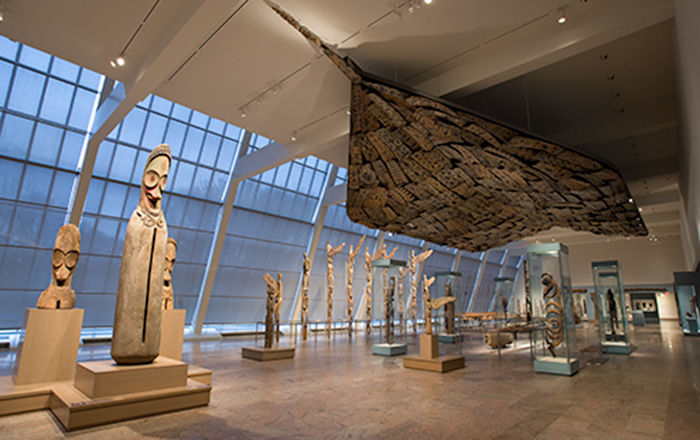Ceremonial jacket (kalambi)
Not on view
This very fine ceremonial jacket (kalambi) incorporates a red foundation of plain weave which features paired arrow stripes in yellow, black and white (in reflected orientation) at both sides. The abstract figurative and geometric patterning covers the entire surface. The front of the jacket features six-pointed stars in diagonal alignment. The back features a pattern in two sections. The upper section features three rows of anthropomorphic figures in stacked rows, each separated vertically by a stylized tree or plant motif which are separated horizontally by a single row of six-pointed stars. The bottom row incorporates doubled stars, along with other abstract shapes into the design. The lower section is bordered with a series of small rectangles featuring a stepped diamond and an inner zig-zag motif. It contains six and one-half figures, again separated by a stylized tree or plant. The expertly executed iconography on the reverse integrates male and female figures with stylized headdresses. A similar sungkit jacket (kalambi) in the Museum of Archaeology and Anthropology collection at the University of Cambridge (Acc. no. 35.904) collected by Charles Hose about 1900, "contains many rows of differently described 'human' figures, the reported names of which, such as 'brave man with war cap,' seem to indicate that [the jacket] was associated in some way with head-hunting’’ (Haddon & Start, 1936, p.46), or at any rate with religious ceremonies.
Created from commercially spun cotton with natural dyes, the sungkit technique (which refers to its discontinuous supplementary weft wrapping) can be particularly appreciated on the front side of the jacket where the design is remarkably straight. The reverse side evidences the raised weft, which, since wrapped, leaves a zig-zag impression. The jacket is classified as second division, from Betong, which is sited near the mouth of the main river. This region was less accessible to Chinese traders who did not likely venture that far up the river, a fact which meant that the design, techniques and iconography of these textiles were preserved from external influence and trade for longer.
